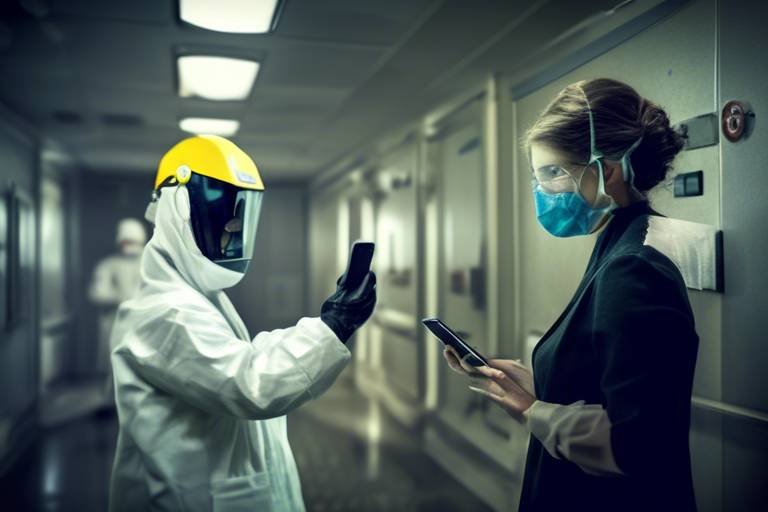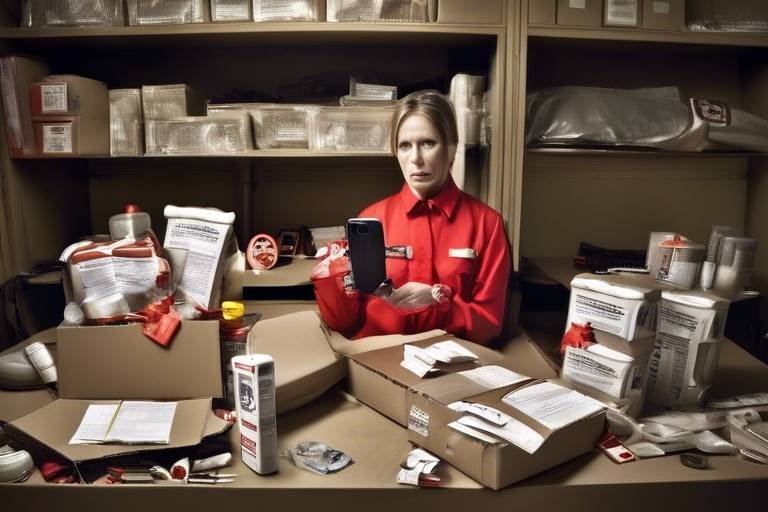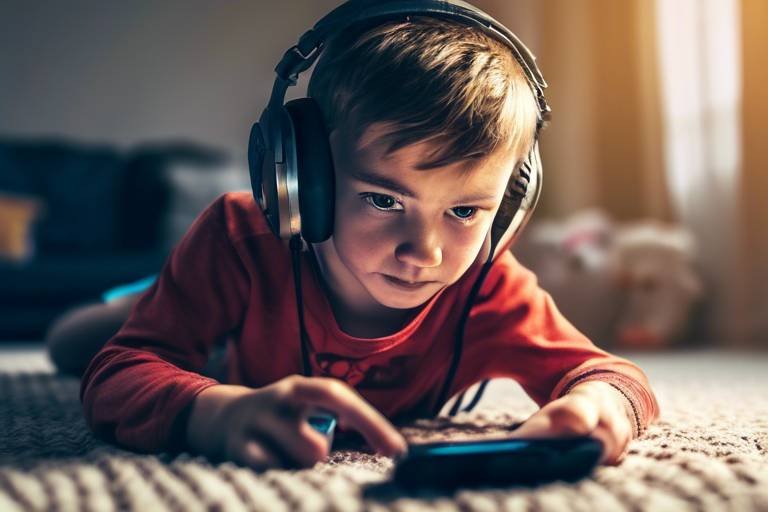Staying Safe amid COVID-19 - A Safety Guide
The COVID-19 pandemic has reshaped our lives in ways we never imagined. As we navigate through these uncertain times, it is crucial to arm ourselves with knowledge and practical strategies to stay safe. This article provides essential tips and guidelines for individuals and families to maintain safety during the ongoing COVID-19 pandemic, focusing on health practices, community support, and mental well-being. Each of us plays a vital role in curbing the spread of the virus, and understanding how to protect ourselves and our loved ones is the first step in this journey.
To effectively protect ourselves, we must first understand how COVID-19 spreads. The virus primarily transmits through respiratory droplets when an infected person coughs, sneezes, or talks. These droplets can land in the mouths or noses of people nearby, or they may be inhaled into the lungs. But that’s not all! The virus can also linger on surfaces for varying lengths of time, meaning touching contaminated surfaces and then touching your face can lead to infection. Moreover, asymptomatic carriers can spread the virus without showing any signs, making it even more critical to adhere to safety measures. By grasping these transmission dynamics, we can appreciate the necessity of preventive measures such as social distancing and wearing masks.
One of the most effective ways to reduce the risk of infection is through diligent personal hygiene. Simple practices such as handwashing, sanitizing, and wearing masks can significantly decrease the likelihood of contracting or spreading the virus. Handwashing is not just about getting your hands wet; it’s about using the right technique and ensuring you wash for at least 20 seconds. When soap and water aren’t available, hand sanitizers become your best friend. Additionally, wearing masks correctly—covering both your mouth and nose—adds an extra layer of protection for you and those around you.
Let’s dive deeper into handwashing techniques. Proper handwashing involves more than just a quick rinse. Start by wetting your hands with clean, running water, then apply soap. Lather up by rubbing your hands together, making sure to scrub the backs of your hands, between your fingers, and under your nails. Rinse well under clean, running water and dry your hands using a clean towel or air dry them. Remember, it’s not just a routine; it’s a critical defense against germs!
Hand sanitizers are a great alternative when soap and water aren't available. However, it’s essential to choose a product that contains at least 60% alcohol. Apply enough product to cover all surfaces of your hands and rub them together until they feel dry. This should take about 20 seconds. But remember, hand sanitizers are not a substitute for handwashing when your hands are visibly dirty or greasy.
Wearing a mask is a simple yet effective way to prevent the spread of COVID-19. Ensure that your mask fits snugly against the sides of your face without gaps. It should cover your nose, mouth, and chin completely. There are various types of masks available, including cloth masks, surgical masks, and N95 respirators. Each serves a purpose, but the key is to wear one consistently in public settings where social distancing is difficult.
Social distancing is another critical strategy in reducing the transmission of COVID-19. Keeping a distance of at least 6 feet from others can significantly lower the risk of inhaling respiratory droplets. But how do we connect with others while maintaining this distance? Consider virtual meetups, phone calls, or even sending a thoughtful text. These alternatives can help maintain our social connections while keeping everyone safe.
Now, let’s talk about vaccinations. They are a cornerstone in the fight against COVID-19. Vaccines work by training our immune systems to recognize and combat the virus. They have proven to be effective in reducing the severity of illness, hospitalization, and death. By getting vaccinated, not only do you protect yourself, but you also contribute to community immunity, helping to shield those who are unable to get vaccinated.
There are several types of COVID-19 vaccines available, including mRNA vaccines, vector vaccines, and inactivated virus vaccines. Each type has undergone rigorous testing to ensure safety and efficacy. Understanding these differences can help demystify the vaccination process and encourage more people to get vaccinated.
Vaccine hesitancy is a real issue that can hinder our progress. Addressing common concerns and misconceptions is vital. Engaging in open conversations, providing accurate information, and sharing personal experiences can help build trust in vaccination efforts. Remember, knowledge is power, and the more we share, the stronger our community becomes.
As we tackle the physical aspects of staying safe, we must also acknowledge the impact of the pandemic on our mental health. Stress, anxiety, and feelings of isolation have surged during these times. It’s essential to recognize these feelings and know that it’s okay to seek help. Whether it’s through mindfulness practices, exercise, or professional support, there are numerous resources available to help us cope.
Identifying signs of stress and anxiety is the first step toward managing them. Symptoms can include irritability, difficulty concentrating, and changes in sleep patterns. Implementing mindfulness techniques, such as meditation or deep-breathing exercises, can help alleviate these feelings. Physical activity is also a fantastic way to boost your mood and reduce stress.
Lastly, maintaining social connections is vital for our mental well-being. Building a support network of friends, family, or community groups can provide a sense of belonging and resilience during these challenging times. Whether it’s a regular check-in call or a virtual game night, these connections can help us feel less isolated and more supported.
Q: What is the best way to protect myself from COVID-19?
A: The best way is to practice good personal hygiene, wear a mask, maintain social distancing, and get vaccinated.
Q: How long should I wash my hands?
A: You should wash your hands for at least 20 seconds to effectively remove germs.
Q: Are COVID-19 vaccines safe?
A: Yes, COVID-19 vaccines have undergone extensive testing to ensure they are safe and effective.
Q: How can I support my mental health during the pandemic?
A: Engage in mindfulness practices, stay connected with loved ones, and seek professional help if needed.

Understanding COVID-19 Transmission
Understanding how COVID-19 spreads is crucial for protecting yourself and your loved ones during this ongoing pandemic. The virus primarily spreads through respiratory droplets that are released when an infected person coughs, sneezes, talks, or breathes. These droplets can land in the mouths or noses of people nearby, which is why maintaining distance from others is so important. But it doesn't stop there; the virus can also linger on surfaces for varying amounts of time, depending on the material. For instance, it can survive on plastic and stainless steel for up to three days!
Another concerning aspect of COVID-19 transmission is the role of asymptomatic carriers. These individuals may not show any symptoms but can still spread the virus to others, making it even more challenging to control its spread. This is why preventive measures, such as wearing masks and practicing good hygiene, are essential. You might wonder, "How can something invisible be so dangerous?" Well, think of it like a silent thief; it can sneak up on you when you least expect it, which is why being vigilant is key.
To further illustrate the ways COVID-19 can spread, consider the following modes of transmission:
- Direct Contact: Touching an infected person or surfaces they have touched.
- Aerosol Transmission: Tiny droplets can linger in the air, especially in enclosed spaces.
- Fomite Transmission: Touching contaminated surfaces and then touching your face.
Understanding these transmission methods empowers you to take proactive steps to protect yourself and your community. For example, by practicing good hygiene, maintaining social distance, and wearing masks, you can significantly reduce the risk of infection. Remember, the more we know, the better we can prepare and protect ourselves. So, let’s stay informed and vigilant!
Q: Can COVID-19 be transmitted through food?
A: Currently, there is no evidence to suggest that COVID-19 is transmitted through food. However, it's always good practice to wash your hands before preparing or eating food.
Q: How long can the virus survive on surfaces?
A: The virus can survive on different surfaces for varying lengths of time. For example, it can live on cardboard for up to 24 hours, while on plastic and stainless steel, it can survive for 2 to 3 days.
Q: What should I do if I think I have been exposed to COVID-19?
A: If you believe you have been exposed, monitor your symptoms, get tested, and follow local health guidelines regarding quarantine and isolation.

Personal Hygiene Practices
In these challenging times, maintaining personal hygiene has never been more critical. It's our first line of defense against the spread of COVID-19. Think of it as your personal shield; the cleaner you are, the more protected you become. But what does this really mean? Let’s dive into some effective practices that can help keep you and your loved ones safe.
First and foremost, handwashing is a crucial practice. It’s not just about splashing some water on your hands and calling it a day. To be effective, you need to wash your hands thoroughly for at least 20 seconds. This means scrubbing all parts of your hands, including the back, between your fingers, and under your nails. A great way to ensure you’re washing long enough is to sing a song—like "Happy Birthday"—twice. It’s fun and effective!
Now, let’s break down the proper technique for handwashing. Start by wetting your hands with clean, running water. Apply soap and lather well, making sure to scrub for at least 20 seconds. Rinse your hands under clean, running water and dry them using a clean towel or air dry. It's simple, yet incredibly effective. If you're curious about the science behind it, washing your hands with soap helps to lift dirt, grease, and germs, which are then rinsed away.
But what happens when soap and water aren’t available? That’s where hand sanitizers come into play. They’re a fantastic alternative, provided you use them correctly. Look for a sanitizer that contains at least 60% alcohol. Apply enough product to cover all surfaces of your hands and rub them together until they feel dry. Remember, though, sanitizers are not a substitute for handwashing when your hands are visibly dirty or greasy.
Another vital aspect of personal hygiene is mask-wearing. Masks are a simple yet powerful tool in reducing the transmission of the virus. When wearing a mask, ensure it covers both your mouth and nose completely. A snug fit is essential, so no gaps should be present. There are various types of masks available, including cloth masks, surgical masks, and N95 respirators. Each type has its own level of protection, but the key is to wear one consistently, especially in crowded or indoor settings.
To summarize, practicing good personal hygiene involves a combination of effective handwashing, appropriate use of hand sanitizers, and proper mask-wearing. These actions not only protect you but also help safeguard those around you. It’s like being part of a community shield—when we all do our part, we reduce the risk of spreading the virus and keep our communities safer.
As we navigate through these uncertain times, remember that personal hygiene is not just a personal responsibility but a collective one. By taking these simple steps, we contribute to a healthier environment for ourselves and others.
- How often should I wash my hands? It's recommended to wash your hands frequently, especially after being in public places, before eating, and after using the restroom.
- Can I use any type of mask? While any mask is better than none, it's best to use masks that fit well and provide adequate filtration, such as surgical masks or cloth masks with multiple layers.
- Is hand sanitizer as effective as handwashing? Hand sanitizer is a good alternative when soap and water aren't available, but washing with soap and water is more effective, especially when hands are visibly dirty.

Handwashing Techniques
Handwashing is often touted as one of the simplest yet most effective methods to prevent the spread of germs and viruses, including COVID-19. But how many of us actually know the correct way to wash our hands? It’s not just about splashing some water and calling it a day! To truly eliminate harmful pathogens, we need to follow proper techniques. First and foremost, you should start by wetting your hands with clean, running water—either warm or cold is fine. Then, apply enough soap to cover all surfaces of your hands.
Now, here’s where the magic happens! You want to scrub your hands together for at least 20 seconds. This duration is crucial; it’s like giving those pesky germs a one-way ticket out of your life. While you’re scrubbing, make sure to get in between your fingers, under your nails, and the backs of your hands. Think of it as a mini workout for your hands! If you’re unsure about the timing, you can sing the "Happy Birthday" song twice or hum your favorite tune. It’s all about making it fun while ensuring you’re thorough!
Once you’ve scrubbed long enough, rinse your hands well under clean, running water. It’s like washing away the stress of the day—only in this case, you’re washing away germs! Finally, dry your hands using a clean towel or air dry them. If you’re in a public restroom, consider using the towel to turn off the faucet and open the door. This way, you’re not reintroducing germs after you’ve just cleaned your hands. Remember, handwashing is your first line of defense!
It’s also essential to debunk some common myths surrounding handwashing. For example, some people believe that using antibacterial soap is significantly better than regular soap. While antibacterial soap does have some advantages, plain soap and water are just as effective in removing germs when done correctly. The key is the scrubbing action, not just the soap itself.
| Myth | Fact |
|---|---|
| Hand sanitizer is better than handwashing. | Handwashing is more effective, especially when hands are visibly dirty. |
| It’s okay to wash hands quickly. | Thorough washing for at least 20 seconds is necessary to eliminate germs. |
| Antibacterial soap is always necessary. | Regular soap is effective when used properly. |
Now that you’re equipped with the right techniques, don’t forget to make handwashing a routine. It’s like brushing your teeth; the more you do it, the better you get at it. Plus, it’s a great habit to instill in children as well. Teaching them the importance of hand hygiene can set them up for a lifetime of good health practices. So, the next time you wash your hands, remember that you’re not just cleaning; you’re protecting yourself and those around you!
Knowing when to wash your hands is just as important as knowing how. Here are some key moments to keep in mind:
- Before eating or preparing food
- After using the restroom
- When caring for someone who is ill
- After coughing, sneezing, or blowing your nose
- Before and after visiting a healthcare facility
By incorporating these handwashing techniques into your daily routine, you’re taking a proactive step in safeguarding not just your health but the health of your community as well. It’s a small action that can have a massive impact!
Q: How long should I wash my hands?
A: You should wash your hands for at least 20 seconds to effectively remove germs.
Q: Can I use hand sanitizer instead of washing my hands?
A: Hand sanitizer is a good alternative when soap and water aren’t available, but handwashing is more effective when your hands are dirty.
Q: What if I don't have soap?
A: If soap is unavailable, use an alcohol-based hand sanitizer that contains at least 60% alcohol.

Using Hand Sanitizers
In today's fast-paced world, hand sanitizers have become an essential tool in our daily hygiene practices, especially during the COVID-19 pandemic. They offer a convenient way to keep our hands clean when soap and water aren't available. But how do you use them effectively? Understanding the right techniques can significantly enhance their effectiveness in killing germs and viruses.
First and foremost, it's important to choose a hand sanitizer that contains at least 60% alcohol. This concentration is crucial for ensuring that the sanitizer is effective against a wide range of pathogens. When selecting a product, look for the Active Ingredient label on the packaging. Here’s a quick overview of what to look for:
| Product Type | Alcohol Content | Effectiveness |
|---|---|---|
| Alcohol-Based Gel | 60-95% | Highly effective |
| Alcohol-Free Gel | 0% | Less effective |
Now that you have your sanitizer, here’s how to use it properly: apply a generous amount to the palm of one hand—about the size of a quarter. Rub your hands together, covering all surfaces, including the backs of your hands, between your fingers, and under your nails. Continue rubbing until your hands feel dry, which should take about 20 seconds. This thorough application is key to ensuring that the sanitizer effectively kills germs.
However, keep in mind that hand sanitizers are not a complete substitute for handwashing. They can reduce the number of germs but may not eliminate all types of germs, especially if your hands are visibly dirty or greasy. In such cases, washing your hands with soap and water is the best option. That said, hand sanitizers are perfect for situations where soap and water are not readily accessible, such as:
- When you're out shopping
- After using public transportation
- Before eating or preparing food
It’s also worth noting that while hand sanitizers are effective, they should be used with caution, especially around children. Always supervise young children when they use hand sanitizer to prevent accidental ingestion, which can be harmful. Additionally, ensure that the sanitizer is stored in a safe place away from heat sources, as alcohol is flammable.
In summary, hand sanitizers are a vital part of our hygiene toolkit during the pandemic. By choosing the right product and using it correctly, you can significantly reduce your risk of infection and contribute to the overall health and safety of your community. Remember, while hand sanitizers are a great alternative when soap and water aren’t available, they should complement, not replace, regular handwashing practices.
1. Can hand sanitizers replace handwashing?
No, hand sanitizers are effective but should not replace handwashing, especially when hands are visibly dirty or greasy. Always wash your hands with soap and water when possible.
2. How much hand sanitizer should I use?
Use enough to cover all surfaces of your hands, typically about the size of a quarter.
3. Are all hand sanitizers equally effective?
No, look for hand sanitizers that contain at least 60% alcohol for maximum effectiveness against germs.
4. Is hand sanitizer safe for children?
Yes, but children should be supervised when using hand sanitizer to prevent ingestion, and it should be stored out of reach.

Mask-Wearing Guidelines
Wearing a mask has become a crucial part of our daily lives during the COVID-19 pandemic. It’s not just a piece of fabric; it’s a shield that protects you and those around you. But how do you ensure you're using it effectively? First off, it's essential to choose the right type of mask. There are various options available, including cloth masks, surgical masks, and N95 respirators. Each serves a purpose, but not all are created equal. For everyday use, a well-fitted cloth mask or a surgical mask is generally sufficient. However, if you're in a high-risk environment or caring for someone who is ill, an N95 respirator is recommended for maximum protection.
Now, let’s talk about how to wear your mask correctly. It should fit snugly against the sides of your face without gaps, covering both your mouth and nose. This is vital; if your mask slips down or doesn’t fit properly, it can defeat the whole purpose of wearing it. Remember, your nose is just as important as your mouth when it comes to preventing the spread of respiratory droplets. Additionally, avoid touching the mask while wearing it. If you do, make sure to wash your hands immediately afterward.
Another key point to consider is the importance of cleanliness. Masks should be washed regularly if they're reusable, ideally after each use. If you're using disposable masks, make sure to dispose of them properly after wearing. Leaving them lying around can pose a risk to others, especially children or pets who might come into contact with them.
When it comes to the setting, there are some guidelines to keep in mind:
- In crowded places where social distancing is difficult, wearing a mask is essential.
- In outdoor settings, masks may not be necessary if you can maintain a safe distance from others.
- Always wear a mask in indoor public spaces, regardless of the number of people present.
Lastly, it’s crucial to stay updated on local regulations regarding mask-wearing. Different areas may have varying guidelines based on the current state of the pandemic. Following these rules not only protects you but also shows respect for your community. Remember, when we wear a mask, we’re not just protecting ourselves; we’re protecting our loved ones, neighbors, and the most vulnerable among us. So let’s all do our part and keep those masks on!
Q: Can I use a face shield instead of a mask?
A: While face shields can provide some protection, they are not a substitute for masks. It’s best to use them in conjunction with a mask for added safety.
Q: How do I know if my mask is effective?
A: A good mask should fit snugly against the sides of your face without gaps, have multiple layers of fabric, and allow you to breathe easily. If you can blow out a candle while wearing it, it may not be effective enough.
Q: Should children wear masks?
A: Yes, children over the age of two should wear masks in public settings, especially when social distancing is hard to maintain. However, ensure that the mask fits properly and that they can wear it safely.
Q: Are there any exceptions to wearing a mask?
A: Yes, individuals with certain health conditions, disabilities, or those who are unconscious or incapacitated may be exempt from wearing a mask. Always consult with a healthcare provider for personalized advice.

Social Distancing Measures
Social distancing is not just a buzzword that popped up during the pandemic; it's a crucial practice designed to slow the spread of COVID-19. Imagine it as a protective bubble around you and your loved ones. By keeping a safe distance from others, you significantly reduce the chances of virus transmission. But how far should that bubble extend? The Centers for Disease Control and Prevention (CDC) recommends maintaining at least 6 feet of distance from others, especially in crowded or enclosed spaces. This distance is based on the understanding that respiratory droplets, which carry the virus, can travel through the air and land on surfaces or directly on other individuals.
Now, you might be wondering, "How do I connect with friends and family if I have to keep my distance?" Fortunately, there are plenty of creative ways to maintain social interactions while adhering to social distancing measures. Virtual hangouts have become the new norm—think video calls, online game nights, and even virtual dinner parties. It’s like having a gathering, but without the risk of spreading germs! Additionally, outdoor activities can be a great way to socialize while keeping your distance. Activities like hiking, biking, or even just taking a walk in the park can allow you to enjoy each other's company while staying safe.
Moreover, it's essential to be mindful of the settings in which you find yourself. Enclosed spaces, especially those with poor ventilation, can increase the risk of transmission. If you have to be indoors, consider the following tips to enhance safety:
| Safety Tip | Description |
|---|---|
| Limit the Number of Attendees | Keep gatherings small to minimize exposure. |
| Improve Ventilation | Open windows and doors to allow fresh air to circulate. |
| Wear Masks | Ensure everyone wears masks, especially when distancing isn’t possible. |
In addition to these measures, it's vital to stay informed about local guidelines and restrictions. Many communities have implemented their own rules based on current infection rates, so keeping an eye on this information can help you make safer choices. Remember, social distancing is a shared responsibility. By doing your part, you're not only protecting yourself but also safeguarding those around you, particularly the most vulnerable populations who may be at higher risk for severe illness.
Lastly, don't forget to check in on your friends and family. A simple text or call can go a long way in maintaining those vital connections. The pandemic may have changed how we interact, but it doesn’t have to diminish our relationships. So, while you’re keeping your distance, remember that you’re not alone in this journey. Together, we can navigate these challenging times with a little creativity and a lot of care.
- What is the recommended distance for social distancing? The CDC recommends maintaining at least 6 feet of distance from others.
- How can I socialize while practicing social distancing? You can use video calls, outdoor activities, or small gatherings while following safety protocols.
- Are masks necessary during social distancing? Yes, masks are recommended, especially in situations where maintaining distance is difficult.

Vaccination Importance
The COVID-19 pandemic has reshaped our lives in unprecedented ways, but one of the most powerful tools we have to combat this virus is vaccination. Vaccines are not just a personal shield; they are a community armor. When we get vaccinated, we not only protect ourselves but also those around us, especially the most vulnerable. It's like creating a fortress of immunity that helps keep the virus at bay. But why is vaccination so crucial in this ongoing battle against COVID-19? Let's dive into the details.
First and foremost, vaccines work by training our immune systems to recognize and fight the virus that causes COVID-19. When you receive a vaccine, it introduces a harmless piece of the virus (like a protein) or a blueprint for making that protein. This primes your immune system to respond swiftly if it encounters the real virus later. Think of it as a fire drill for your immune system—preparing it for the real event without the actual danger. As a result, vaccinated individuals are less likely to experience severe illness, hospitalization, or death from COVID-19.
Moreover, the effectiveness of vaccines has been proven through extensive research and real-world data. According to various studies, vaccinated people are significantly less likely to contract COVID-19 compared to those who are unvaccinated. This is crucial for controlling the spread of the virus. When a large portion of the population gets vaccinated, we move closer to achieving herd immunity, which is essential for protecting those who cannot be vaccinated, such as individuals with certain medical conditions or allergies.
To illustrate the importance of vaccination, let’s take a look at some statistics:
| Vaccination Status | Risk of Severe Illness | Hospitalization Rate |
|---|---|---|
| Unvaccinated | High | 20% or more |
| Partially Vaccinated | Moderate | 10% or less |
| Fully Vaccinated | Low | 1% or less |
These numbers speak volumes about the effectiveness of vaccines in reducing the severity of illness and the need for hospitalization. It's a clear message: getting vaccinated is one of the best choices you can make for your health and the health of your community.
However, despite the overwhelming evidence supporting the safety and efficacy of COVID-19 vaccines, some individuals still harbor doubts or fears. This phenomenon, known as vaccine hesitancy, can be fueled by misinformation or a lack of understanding about how vaccines work. Addressing these concerns is vital for increasing vaccination rates. Open conversations, sharing reliable information, and listening to people's worries can help foster trust in vaccination efforts.
In conclusion, the importance of COVID-19 vaccination cannot be overstated. It is not just a personal decision; it is a collective responsibility. By getting vaccinated, we contribute to a safer environment for ourselves and our loved ones. It's time to roll up our sleeves and join the fight against COVID-19—together, we can make a difference.
- What are the side effects of COVID-19 vaccines? Most side effects are mild and temporary, such as soreness at the injection site, fatigue, or mild fever.
- Can vaccinated individuals still spread the virus? While vaccinated individuals are less likely to spread the virus, it is still possible, especially with variants. Continuing safety measures is essential.
- How long does immunity last after vaccination? Current data suggests that immunity may wane over time, which is why booster shots are recommended for continued protection.

Types of COVID-19 Vaccines
The development of COVID-19 vaccines has been one of the most significant scientific achievements in recent history. With various types of vaccines available, it's essential to understand how they work and their role in combating the pandemic. The primary types of COVID-19 vaccines include:
- mRNA Vaccines: These vaccines, such as the Pfizer-BioNTech and Moderna vaccines, use messenger RNA to instruct cells to produce a harmless piece of the spike protein found on the surface of the virus. This triggers an immune response, teaching the body to recognize and fight the virus if exposed in the future.
- Viral Vector Vaccines: Vaccines like the Johnson & Johnson and AstraZeneca vaccines use a harmless virus (not the coronavirus) as a vector to deliver genetic material that codes for the spike protein. This method also stimulates an immune response without causing the disease.
- Protein Subunit Vaccines: These vaccines contain harmless pieces of the virus (proteins) instead of the entire germ. The Novavax vaccine is an example, and it works by presenting these proteins to the immune system, prompting a response.
Each type of vaccine has undergone rigorous testing to ensure safety and efficacy. The mRNA vaccines, for instance, have shown to be highly effective in preventing COVID-19, even against variants, while viral vector vaccines have demonstrated strong immune responses as well. The choice of vaccine may depend on various factors, including availability, health conditions, and personal preferences.
It's also important to note that the vaccines require two doses for maximum effectiveness in most cases, with the exception of the Johnson & Johnson vaccine, which is a single-dose shot. After receiving the vaccine, individuals may experience mild side effects, such as soreness at the injection site, fatigue, or mild fever, which are normal signs that the body is building protection.
As we navigate through this pandemic, understanding the types of COVID-19 vaccines available can empower individuals to make informed decisions about their health. Vaccination not only protects you but also contributes to the broader goal of achieving herd immunity, ultimately helping to end the pandemic.
1. Are COVID-19 vaccines safe?
Yes, COVID-19 vaccines have undergone extensive clinical trials to ensure their safety and efficacy before being authorized for public use. Side effects are usually mild and temporary.
2. How effective are the vaccines against variants?
While some variants may reduce vaccine effectiveness, the vaccines still provide significant protection against severe illness, hospitalization, and death caused by these variants.
3. Do I still need to wear a mask after being vaccinated?
Yes, it is advisable to continue wearing masks in crowded or enclosed spaces, especially if local transmission rates are high, until community immunity is achieved.
4. Can I choose which vaccine to receive?
Depending on availability and local health policies, you may have the option to choose your vaccine. However, it's crucial to get vaccinated with whichever vaccine is available to you.

Addressing Vaccine Hesitancy
Vaccine hesitancy is a growing concern that can hinder our progress in combating COVID-19. Many people have reservations about getting vaccinated, often fueled by misinformation, fear, or a lack of understanding. It's crucial to address these hesitations head-on to foster a more informed community. First, we need to understand that it's completely normal to have questions. After all, the development of vaccines was rapid, and with so much information swirling around, it can be overwhelming.
To tackle vaccine hesitancy effectively, we must engage in open conversations. It's important to listen to people's concerns without judgment. For example, some individuals may worry about the side effects of vaccines. Here, we can clarify that while some people experience mild side effects, such as soreness at the injection site or fatigue, these are typically short-lived and are signs that the body is building protection. To illustrate this point further, consider the following table that compares common vaccine side effects with their expected duration:
| Side Effect | Expected Duration |
|---|---|
| Soreness at Injection Site | 1-2 days |
| Fatigue | 1-2 days |
| Headache | 1-2 days |
| Fever | 1-3 days |
Another effective strategy is to share credible information from trusted sources. Health organizations like the World Health Organization (WHO) and the Centers for Disease Control and Prevention (CDC) provide reliable data that can help dispel myths. Encourage individuals to visit these sites or consult with healthcare professionals who can provide personalized answers to their questions. This approach not only empowers individuals with knowledge but also builds trust in the vaccination process.
Furthermore, stories of community members who have been vaccinated can have a profound impact. Personal testimonials can humanize the experience and illustrate the positive outcomes of vaccination. When someone hears that their neighbor, friend, or family member received the vaccine and felt safe afterward, it can alleviate fears and encourage others to take the step towards vaccination.
Lastly, addressing logistical concerns is essential. Some may hesitate due to worries about access to vaccines or the time commitment required to get vaccinated. By providing information about local vaccination sites, hours of operation, and even transportation options, we can make the process more accessible. Organizing community vaccination events can also create a sense of camaraderie and collective action, making the experience less daunting.
In conclusion, addressing vaccine hesitancy is not just about providing information; it's about fostering understanding, building trust, and creating a supportive environment. By engaging in respectful dialogue, sharing credible resources, highlighting personal experiences, and addressing logistical challenges, we can encourage more individuals to embrace vaccination as a vital step towards protecting themselves and their communities from COVID-19.
- What is vaccine hesitancy? Vaccine hesitancy refers to the reluctance or refusal to vaccinate despite the availability of vaccines. It can stem from various factors, including misinformation, fear, and lack of trust in the healthcare system.
- How can I convince someone who is hesitant about getting vaccinated? Engage them in a respectful conversation, listen to their concerns, and provide credible information from trusted health organizations. Sharing personal testimonials can also be effective.
- What are the common side effects of COVID-19 vaccines? Common side effects include soreness at the injection site, fatigue, headache, and mild fever. These side effects typically resolve within a few days.
- Where can I find reliable information about COVID-19 vaccines? Trusted sources include the World Health Organization (WHO), the Centers for Disease Control and Prevention (CDC), and your local health department.

Mental Health Considerations
The COVID-19 pandemic has not only taken a toll on our physical health but has also significantly impacted our mental well-being. Many individuals are experiencing heightened levels of stress, anxiety, and uncertainty, which can lead to feelings of isolation and despair. It's crucial to acknowledge these feelings and understand that you’re not alone in this struggle. Just like we take precautions to protect our bodies from the virus, we must also take steps to safeguard our mental health.
Recognizing signs of stress and anxiety is the first step towards managing them effectively. Symptoms can manifest in various ways, including changes in sleep patterns, irritability, difficulty concentrating, and even physical symptoms like headaches or stomach issues. If you find yourself feeling overwhelmed, it’s essential to reach out for help. Remember, seeking support is a sign of strength, not weakness.
To help manage stress and anxiety, consider incorporating some coping strategies into your daily routine. Here are a few effective methods:
- Mindfulness and Meditation: Taking a few moments each day to practice mindfulness or meditation can help center your thoughts and reduce anxiety. Apps like Headspace or Calm can guide you through simple meditation exercises.
- Physical Activity: Regular exercise is a powerful stress reliever. Even a short walk can boost your mood and help clear your mind.
- Stay Connected: Maintaining social connections is vital during these times. Schedule regular video calls or virtual hangouts with friends and family to foster those important relationships.
Building a support network is another key aspect of maintaining mental health during the pandemic. This network can include friends, family, or even support groups that you can join online. Sharing your feelings and experiences with others can provide comfort and reassurance, reminding you that you are not alone in this journey. Consider the following ways to strengthen your support system:
- Join online communities or forums focused on mental health.
- Participate in local virtual events or group activities.
- Reach out to mental health professionals if you're feeling overwhelmed.
In addition to these strategies, it’s important to be aware of the resources available to you. Many organizations offer free or low-cost mental health services, including hotlines for immediate support. Don't hesitate to use these resources; they are there to help you. Remember, taking care of your mental health is just as important as taking care of your physical health during these challenging times.
Ultimately, the key to navigating the mental health challenges posed by the pandemic lies in being proactive. By recognizing your feelings, seeking support, and utilizing coping strategies, you can foster resilience and maintain a positive outlook. Together, we can emerge from this pandemic not just physically healthy, but mentally strong as well.
| Question | Answer |
|---|---|
| How can I tell if I'm experiencing anxiety due to COVID-19? | Common signs include excessive worrying, changes in sleep or appetite, and difficulty concentrating. If these symptoms persist, consider seeking professional help. |
| What are some quick ways to relieve stress at home? | Try deep breathing exercises, take a short walk, or engage in a hobby you enjoy to relieve stress quickly. |
| Where can I find mental health resources? | Many mental health organizations offer resources online, including hotlines and virtual therapy sessions. Check local health department websites for more information. |

Recognizing Stress and Anxiety
In these unprecedented times, it's completely normal to feel a surge of stress and anxiety. The constant stream of news, the fear of illness, and the uncertainty about the future can weigh heavily on anyone's mind. So, how do you recognize when these feelings are more than just a passing phase? Understanding the signs is the first step in managing your mental health effectively.
Stress often manifests physically and emotionally. You might notice symptoms such as increased heart rate, difficulty sleeping, or even irritability. On the other hand, anxiety can creep in as a constant feeling of dread or worry about the unknown. It's like carrying a backpack filled with rocks; the longer you carry it, the heavier it feels. If you find yourself feeling overwhelmed, it's essential to pause and evaluate your mental state.
Common signs of stress and anxiety include:
- Changes in appetite: You might find yourself eating more or less than usual.
- Difficulty concentrating: Tasks that once seemed straightforward may now feel daunting.
- Physical symptoms: Headaches, stomach issues, or muscle tension can be telltale signs.
- Social withdrawal: You may feel like isolating yourself from friends and family.
Recognizing these signs early on can be crucial. It's like spotting a crack in a dam before it bursts; addressing issues before they escalate can save you from a flood of emotions later. If you notice these symptoms persisting, it might be time to reach out for help. Speaking to a professional can provide you with tools to cope and navigate through these turbulent times.
Moreover, don't underestimate the power of mindfulness and self-care. Engaging in activities that you love can act as a balm for your mental health. Whether it's reading a book, taking a long walk, or practicing yoga, these moments of joy can help alleviate stress and anxiety. Remember, it's okay to feel what you're feeling; acknowledging your emotions is the first step toward healing.
In conclusion, recognizing stress and anxiety is not just about identifying symptoms but also about understanding how they affect your daily life. By being aware and taking proactive steps, you can manage your mental health more effectively during these challenging times.
Q1: What are some immediate steps I can take to reduce stress and anxiety?
A1: Some immediate steps include practicing deep breathing, engaging in physical activity, and reaching out to friends or family for support. Even a short walk can make a significant difference!
Q2: How can I differentiate between stress and anxiety?
A2: Stress is typically a response to an external trigger, while anxiety is more about persistent worry that may not be linked to a specific event. If you're feeling overwhelmed without a clear reason, it may be anxiety.
Q3: When should I seek professional help?
A3: If your symptoms persist for more than a few weeks, interfere with your daily life, or if you feel hopeless, it's time to consult a mental health professional.

Building a Support Network
In these challenging times, is not just a nice-to-have; it’s essential for our well-being. Think of your support network as a safety net—a group of friends, family, and community members who can catch you when you fall and lift you up when you need it most. Whether it’s a chat over coffee or a virtual hangout, these connections can provide the emotional support that helps us navigate the uncertainties of life during a pandemic.
So, how do you go about creating this network? First, start with the people you already know. Reach out to friends and family members. You might be surprised at how many are also looking for connection. Consider organizing regular check-ins, whether through video calls, phone calls, or even text messages. This way, you can share your experiences, feelings, and coping strategies. Remember, it’s not about having a large group; it’s about having a few trusted people who can offer genuine support.
Next, look beyond your immediate circle. Community groups, online forums, and social media platforms can be great places to meet new people who share similar interests or experiences. Joining a local group or an online community can help you connect with others who are navigating similar challenges. For instance, many neighborhoods have started virtual meet-ups or support groups focused on mental health, parenting, or even hobbies. Engaging in these spaces can foster new friendships and broaden your support system.
Additionally, consider the role of professional support. Therapists, counselors, and mental health professionals can provide valuable assistance, especially if you’re feeling overwhelmed. They can help you develop coping strategies and provide a safe space to express your feelings. If you’re unsure where to start, many organizations offer resources and referrals to mental health services. It’s important to remember that seeking help is a sign of strength, not weakness.
Lastly, don't forget to give back to your support network. Just as you seek support, your friends and family may also need a listening ear or a helping hand. Being there for others can strengthen your bonds and create a sense of community. You might even find that helping others can boost your own mood and resilience. After all, we’re all in this together, and a little kindness can go a long way.
In summary, building a support network involves reaching out, engaging with your community, seeking professional help when needed, and reciprocating support. By taking these steps, you can create a robust support system that not only helps you cope with the challenges of COVID-19 but also enriches your life in ways you may not have anticipated.
- What is a support network? A support network is a group of people who provide emotional, social, and sometimes financial support to one another. This can include friends, family, colleagues, and community members.
- How can I find people to include in my support network? You can start with friends and family, join local community groups, participate in online forums, or engage in social media platforms related to your interests.
- What if I feel uncomfortable reaching out to others? It’s completely normal to feel hesitant. Start small by reaching out to just one person you trust, and gradually expand your network as you become more comfortable.
- Can professional help be part of my support network? Absolutely! Therapists and counselors can provide invaluable support and should be considered a key part of your overall support system.
Frequently Asked Questions
- What are the main ways COVID-19 spreads?
COVID-19 primarily spreads through respiratory droplets when an infected person coughs, sneezes, or talks. It can also spread by touching surfaces contaminated with the virus and then touching your face, especially your mouth, nose, or eyes. Understanding these transmission methods is crucial for implementing effective preventive measures.
- How can I effectively wash my hands?
To wash your hands effectively, use soap and water, scrubbing for at least 20 seconds. Make sure to clean all parts of your hands, including between your fingers and under your nails. If soap and water aren't available, use a hand sanitizer that contains at least 60% alcohol.
- Why is wearing a mask important?
Wearing a mask helps reduce the spread of respiratory droplets, protecting both you and those around you. It’s especially important in crowded or indoor settings where social distancing is difficult. Remember to cover both your mouth and nose for maximum effectiveness!
- What is social distancing, and how can I practice it?
Social distancing means keeping a safe distance—at least 6 feet—from others to minimize the risk of virus transmission. You can practice it by avoiding large gatherings, using virtual communication tools to stay connected, and opting for outdoor activities when meeting friends.
- Why is vaccination important during the pandemic?
Vaccination is crucial because it helps protect you from severe illness and contributes to herd immunity, which can slow down the spread of the virus in the community. Vaccines have been shown to be effective in reducing hospitalizations and deaths related to COVID-19.
- What types of COVID-19 vaccines are available?
There are several types of COVID-19 vaccines, including mRNA vaccines (like Pfizer-BioNTech and Moderna), viral vector vaccines (like Johnson & Johnson), and protein subunit vaccines. Each type works differently but has been shown to provide strong protection against the virus.
- How can I address vaccine hesitancy?
To address vaccine hesitancy, it’s essential to provide accurate information and listen to concerns. Sharing personal experiences, discussing the benefits of vaccination, and encouraging conversations with healthcare professionals can help build trust and alleviate fears.
- What are some signs of stress and anxiety related to COVID-19?
Signs of stress and anxiety may include difficulty sleeping, changes in appetite, increased irritability, and feelings of sadness or hopelessness. Recognizing these signs early can help you seek support and manage your mental health effectively.
- How can I build a support network during the pandemic?
Building a support network can involve reaching out to friends and family, joining online communities, or participating in local support groups. Regular check-ins with loved ones and sharing your feelings can foster connections and provide emotional support.



















